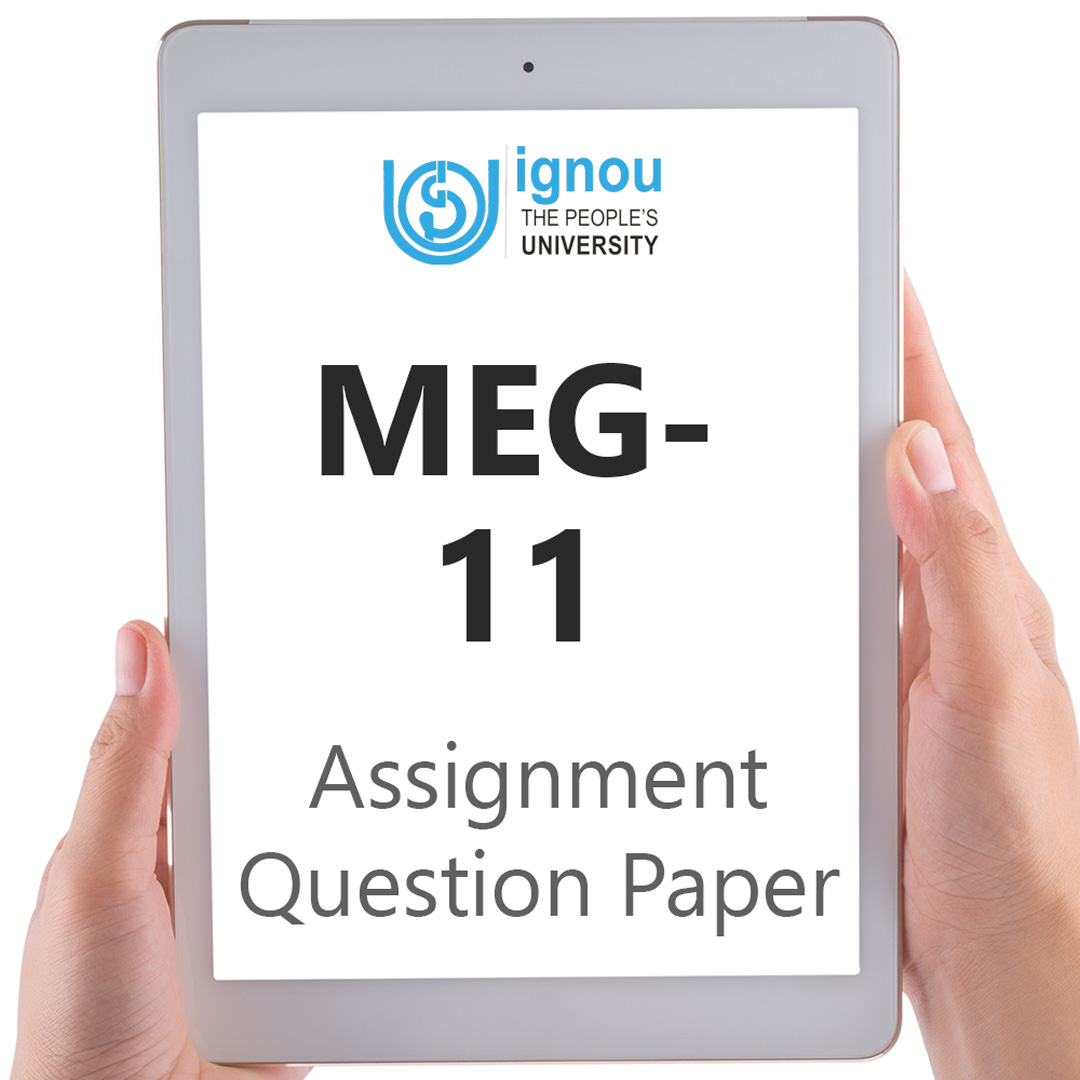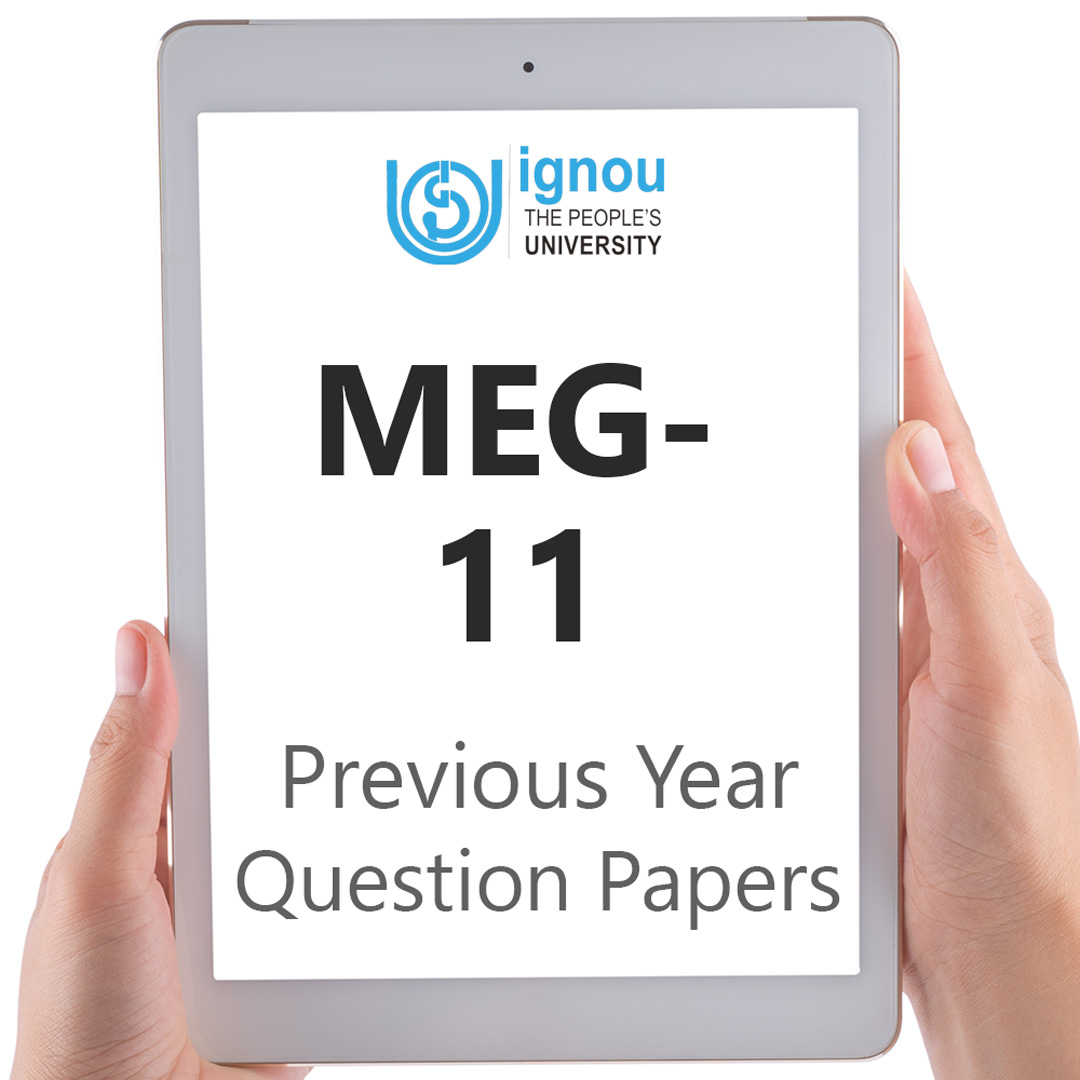If you are looking for MEG-11 IGNOU Solved Assignment solution for the subject American Novel, you have come to the right place. MEG-11 solution on this page applies to 2023-24 session students studying in MEG, PGDNOV, PGDAML courses of IGNOU.
MEG-11 Solved Assignment Solution by Gyaniversity
Assignment Code: MEG-11/ TMA/2023-24
Course Code: MEG-11
Assignment Name: American Novel
Year: 2023-2024
Verification Status: Verified by Professor
Q1) Critically examine the chief characteristics of Black American Women’s writings. Illustrate your answer with reference to the novel prescribed in your syllabus.
Ans) Black American women's writings have evolved over time and encompass a range of characteristics that reflect the unique experiences, struggles, and perspectives of African American women. These writings have played a significant role in shedding light on the intersection of race, gender, and class in American society.
Intersectionality: Black American women's writings often explore the concept of intersectionality, which acknowledges that individuals can experience multiple forms of oppression simultaneously. These writings delve into the complex interplay between race, gender, and class, highlighting how these intersecting identities shape the lives of Black women. For instance, in Toni Morrison's "The Bluest Eye," the character Pecola Breedlove's experiences reflect the devastating impact of racism and gendered beauty standards on her self-esteem and identity.
Challenging Stereotypes: Black American women writers have been at the forefront of challenging and deconstructing stereotypes about Black women. They refuse to conform to one-dimensional portrayals and instead offer multidimensional, authentic depictions of their characters. In Alice Walker's "The Colour Purple," Celie undergoes a transformation from a submissive and oppressed woman to a self-assured and independent individual, defying the stereotype of the passive Black woman.
Exploring Identity and Self-Discovery: Many Black American women's novels delve into themes of identity and self-discovery. Characters grapple with questions of who they are in a society that often marginalizes and devalues them. In Toni Morrison's "Song of Solomon," Macon Dead III embarks on a journey of self-discovery that takes him from his oppressive family history to a deeper understanding of his roots and identity.
Community and Solidarity: Black American women's writings emphasize the importance of community and solidarity in the face of adversity. These novels depict the support networks, friendships, and bonds that sustain Black women in their struggles. Gloria Naylor's "The Women of Brewster Place" explores the interconnected lives of the women living in a housing project, highlighting the strength they draw from their collective experiences.
Voices and Narratives: Black American women's writings prioritize the amplification of Black women's voices and narratives. They provide a platform for marginalized voices to be heard and stories to be shared. In Ntozake Shange's "Sassafras, Cypress and Indigo," the author uses a unique narrative style, combining poetry, letters, and recipes to convey the experiences and creativity of her characters.
Social and Political Commentary: These writings often serve as vehicles for social and political commentary. They address pressing issues such as racism, sexism, poverty, and inequality. Audre Lorde's "Zami" is a powerful exploration of her experiences as a Black lesbian woman and offers insightful critiques of societal norms and expectations.
Diverse Narrative Styles: Black American women authors employ diverse narrative styles, including oral traditions, folklore, and experimentation with language. This diversity reflects the rich tapestry of African American culture. For example, Jewelle Gomez's "The Gilda Stories" reimagines vampire lore through an African American and lesbian lens, highlighting the versatility of storytelling.
Q2) Discuss the common themes in the novels of Theodore Dreiser. Answer with suitable examples.
Ans) Theodore Dreiser, an influential American novelist of the late 19th and early 20th centuries, is known for his realistic and often gritty portrayals of American society. His novels typically explore common themes that reflect the complexities and struggles of individuals within an industrialized and capitalistic America.
Social Determinism:
Dreiser frequently explores the idea that an individual's fate is shaped by social and economic forces beyond their control. Characters often find themselves caught in the grip of circumstances.
Example: In "Sister Carrie," the protagonist Carrie Meeber's life takes a series of turns as she navigates the challenges of a rapidly changing urban landscape. Her trajectory from a small-town girl to a successful actor is influenced by her environment and opportunities.
The American Dream:
Dreiser often examines the pursuit of the American Dream, where characters strive for success, wealth, and social status. However, he portrays the dream as elusive and sometimes unattainable.
Example: In "An American Tragedy," Clyde Griffiths aspires to climb the social ladder and marry a wealthy woman. His pursuit of the American Dream leads him to make morally questionable choices, resulting in tragedy.
Materialism and Consumerism:
Dreiser critiques the materialistic and consumer-driven nature of American society. Characters are frequently driven by desires for wealth, luxury, and social status.
Example: In "The Financier," the protagonist Frank Cowperwood's relentless pursuit of financial success and opulence illustrates the corrosive effects of materialism on personal values and relationships.
Moral Ambiguity:
Dreiser often portrays characters who grapple with moral ambiguity, making choices that challenge conventional notions of right and wrong.
Example: In "Jennie Gerhardt," the eponymous character Jennie finds herself in morally compromising situations as she navigates the complexities of love and social expectations.
Naturalism:
Dreiser is associated with the naturalist literary movement, which emphasizes the influence of heredity and environment on human behaviour. His characters often face harsh, deterministic circumstances.
Example: In "Jennie Gerhardt," the characters' lives are shaped by poverty, illness, and societal expectations, reflecting the naturalist belief in the inescapable forces that govern human existence.
Gender Roles and Sexuality:
Dreiser's novels often explore the restrictive gender roles and societal expectations placed on women, as well as the consequences of nonconformity.
Example: In "Sister Carrie," the character of Carrie Meeber defies traditional gender norms by pursuing a career in the theatre and exploring her sexuality. Her choices challenge the expectations placed on women in the early 20th century.
Class Struggles:
Dreiser frequently delves into class divisions and the tensions between social classes. His characters often experience the disparities and inequalities inherent in a capitalist society.
Example: In "The Titan," the struggle between the working class and the wealthy elite is central to the plot. The character of Cowperwood represents the upper class, while others, such as the labour organizer Butler, advocate for the rights of the working class.
Isolation and Loneliness:
Many of Dreiser's characters experience profound isolation and loneliness as they grapple with their personal and societal challenges.
Example: In "Sister Carrie," both Carrie and her lover Hurstwood experience a sense of isolation and detachment as they pursue their individual ambitions, highlighting the loneliness that can accompany personal success.
Q3) Would you agree that Faulkner explores the issue of racial identity through the portrayal of the character of Joe Christmas in Light in August ?
Ans) Yes, William Faulkner explores the complex issue of racial identity through the character of Joe Christmas in his novel "Light in August." Joe Christmas serves as a central figure through whom Faulkner examines themes of racial ambiguity, prejudice, and the search for identity in a racially segregated and prejudiced society.
Racial Ambiguity:
Joe Christmas's racial identity is ambiguous and uncertain throughout the novel. He is rumoured to have some African American ancestry, which becomes a source of social stigma and discrimination. This ambiguity highlights the arbitrary and unjust nature of racial classifications in the Jim Crow South.
Alienation and Self-Identity:
Joe Christmas grapples with a deep sense of alienation and struggles to define his own identity. He is torn between different racial and cultural influences, feeling neither fully white nor fully Black. This internal conflict reflects the broader societal tensions and anxieties surrounding racial identity in the American South.
Prejudice and Discrimination:
Faulkner depicts the pervasive racism and discrimination that Joe Christmas faces throughout his life. He experiences prejudice from both Black and white communities, illustrating the destructive impact of racial hatred and societal divisions.
Symbolism of the 'One-Drop Rule':
The novel explores the concept of the "one-drop rule," a racial classification system that considered anyone with even a single drop of African ancestry as Black. Joe Christmas's experiences demonstrate the arbitrary and unjust nature of this rule, as he is subjected to discrimination based on perceived racial impurity.
Interpersonal Relationships:
Joe Christmas's relationships with other characters in the novel are heavily influenced by his racial ambiguity. His romantic involvement with Joanna Burden, a white woman, is particularly significant. The relationship is marked by a sense of racial guilt and fear, reflecting the societal taboos of interracial relationships during the era.
Violence and Ostracism:
The novel portrays the violence and ostracism that Joe Christmas faces due to his racial ambiguity. His ultimate act of violence against Joanna Burden can be seen as a culmination of the societal pressures and internal conflicts he experiences.
Search for Redemption and Identity:
Joe Christmas's journey can also be interpreted as a quest for redemption and self-identity. His actions, though often morally ambiguous, can be seen as attempts to reconcile his fractured sense of self and find a place in a society that refuses to accept him.
Narrative Complexity:
Faulkner employs a non-linear narrative style in "Light in August," shifting perspectives and timelines to create a complex and multifaceted portrayal of Joe Christmas's character. This narrative complexity reflects the intricate nature of racial identity and the subjective perceptions of individuals within the story.
Broader Social Commentary:
While Joe Christmas's story is deeply personal, Faulkner uses it to comment on the broader social and historical context of the American South. Through his character, he highlights the destructive impact of racial prejudice and the oppressive racial hierarchies that governed Southern society.
Q4) Critically comment on the concept of the ‘‘American Dream’’ in The Great Gatsby.
Ans) F. Scott Fitzgerald's novel "The Great Gatsby" is often regarded as a quintessential exploration of the American Dream, a concept that has been central to the American identity and ethos. However, Fitzgerald's portrayal of the American Dream in the novel is complex and critical, revealing both its aspirational allure and its elusive and corrupt nature.
Materialism and Wealth:
The American Dream, as depicted in the novel, is closely tied to material success and the accumulation of wealth. Jay Gatsby, the novel's enigmatic protagonist, embodies the pursuit of material success as a means of achieving the American Dream. He amasses great wealth in his quest to win back Daisy Buchanan, his lost love. This materialistic interpretation of the American Dream highlights the shallow and materialistic values of society in the Jazz Age.
Illusion vs. Reality:
Fitzgerald underscores the theme of illusion versus reality throughout the novel. Gatsby, driven by his dream of rekindling his romance with Daisy, constructs an elaborate facade of wealth and opulence. This illusion, however, masks the reality of moral corruption and emotional emptiness. The contrast between Gatsby's illusion and the grim reality of his life exposes the hollowness of the American Dream when pursued solely for material gain.
The Corruption of the Dream:
The novel suggests that the pursuit of the American Dream can lead to moral decay and the corruption of values. Characters like Tom and Daisy Buchanan, who are born into wealth, exemplify this moral decay as they live recklessly and without consequences. Their careless pursuit of pleasure illustrates the moral bankruptcy that can result from the relentless pursuit of the American Dream.
Social Class and Inequality:
"The Great Gatsby" explores the theme of social class and the role it plays in the American Dream. The characters in the novel are acutely aware of their social status and are often preoccupied with maintaining or elevating their position in society. This obsession with social class highlights the rigid barriers that exist within the American Dream, as social mobility remains elusive for many.
The Elusiveness of Happiness:
The novel suggests that the American Dream promises happiness and fulfilment but often fails to deliver. Despite his immense wealth, Gatsby is unable to attain the happiness he seeks, as it is forever tied to a past that can never be fully recaptured. This underscores the idea that the pursuit of the American Dream can be a fruitless quest for an idealized version of happiness.
Critique of the Jazz Age:
Fitzgerald's portrayal of the American Dream in "The Great Gatsby" is also a critique of the excesses and superficiality of the Jazz Age. The hedonistic parties, reckless behaviour, and moral decadence of the characters reflect the broader societal values of the era. The American Dream, as depicted in the novel, is intertwined with the extravagance and superficiality of the Jazz Age.
The Green Light:
The green light at the end of Daisy's dock symbolizes Gatsby's unattainable dream. It represents the distant hope of a better future and the elusive nature of the American Dream. Gatsby gazes at the green light across the bay, yearning for a future that remains forever out of reach.
Tragic Ending:
The tragic ending of the novel, culminating in Gatsby's death, serves as a poignant commentary on the American Dream. Gatsby's relentless pursuit of his dream leads to his downfall, highlighting the destructive consequences of unwavering ambition and the inherent fragility of the Dream.
Q5) Discuss the major themes and characters of the novel The Catcher in the Rye.
Ans) "The Catcher in the Rye" by J.D. Salinger is a classic novel that explores the struggles of its teenage protagonist, Holden Caulfield, as he navigates the complexities of adolescence and the adult world. The novel delves into several major themes and features a cast of memorable characters.
Alienation and Disillusionment:
Holden Caulfield is profoundly alienated from the adult world, which he perceives as phony, hypocritical, and corrupt. His alienation leads to feelings of disillusionment, and he struggles to find authenticity and meaning in a world he views as insincere.
Identity and Authenticity:
Holden is on a quest to discover his identity and to be authentic in a world that he believes values conformity and pretence. He despises phoniness and seeks genuine connections and experiences.
Loss of Innocence:
The novel explores the loss of innocence that accompanies the transition from childhood to adulthood. Holden's concern for the preservation of innocence is evident in his fantasy of being the "catcher in the rye," preventing children from falling into the abyss of adulthood.
Loneliness and Isolation:
Holden is a deeply lonely character who often feels isolated from others. He struggles to connect with people and frequently pushes them away, even though he longs for companionship.
Phoniness and Hypocrisy:
Holden's aversion to phoniness and hypocrisy is a recurring theme. He is critical of the superficiality and insincerity he perceives in adult society, especially in people who pretend to be something they are not.
Depression and Mental Health:
Throughout the novel, Holden exhibits signs of depression and struggles with his mental health. His alienation and disillusionment contribute to his emotional turmoil.
The Inevitability of Growing Up:
While Holden yearns to protect the innocence of childhood, he also recognizes the inevitability of growing up. He grapples with the tension between his desire to preserve innocence and the reality of adulthood.
Holden Caulfield:
The novel's protagonist and narrator, Holden is a troubled teenager who has been expelled from several prep schools. He is extremely critical of the adult world and is searching for authenticity and meaning in his life.
Phoebe Caulfield:
Holden's younger sister, Phoebe is a bright and perceptive child who cares deeply for her brother. She represents innocence and serves as a source of comfort and stability for Holden.
Allie Caulfield:
Allie, Holden's younger brother, passed away from leukaemia several years before the events of the novel. Holden adores Allie and is haunted by his death. Allie represents purity and the loss of innocence.
Jane Gallagher:
Jane is a girl Holden cares about deeply, and he is troubled by the thought of her being mistreated by her abusive stepfather. She represents Holden's longing for genuine connections.
Mr. Antolini:
Mr. Antolini is a former English teacher of Holden's. He is one of the few adults Holden respects. He offers Holden advice and a place to stay when he is feeling lost and vulnerable.
Sally Hayes:
Sally is a girl Holden goes on a date within New York City. While he is initially infatuated with her, he becomes disillusioned with her conformist attitudes and shallow behaviour.
Mr. Spencer:
Mr. Spencer is one of Holden's former teachers who tries to impart wisdom to him about the importance of education and responsibility.
Stradlater, Ackley, and Maurice:
These are Holden's peers at Pencey Prep. Stradlater is his roommate and represents superficiality, Ackley is a neighbour who annoys Holden, and Maurice is a hotel elevator operator who defrauds Holden.





